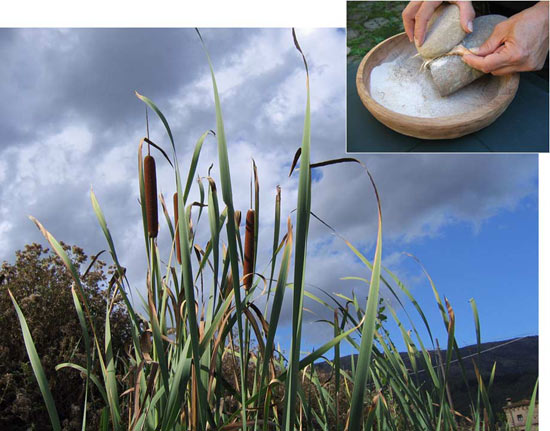Discovering human species knows how to process food 20,000 years ago
New research suggests that our ancestors had early skills in cooking food.Italian scientists have found archaeological evidence proving that humans have grinded flour 20,000 years ago, and that many years people have used cereal grains in the menu every day before farming. become a standard in society.
The idea that ' hunter ' plays a key role in the life of prehistoric people is an early prejudice. It is an exaggerated thought, according to Anna Revedin, working at the Italian Institute of Prehistory and Early Histor in Florence, Italy. Although meat plays a key role, she says, but plants are still the most important dish in the daily menu of prehistoric people.

Although plants do not survive as long as animal bones, researchers have found evidence of the very early existence of powder grinding tools in prehistoric archaeological sites, rocks. The stone is smudged like a lipstick to paint on the face of the prehistoric people or the walls of the cave .
This is the reason why these new findings are so important, Revedin said, Revedin's team has discovered traces of prehistoric starches left on burial powdered tools at 3 prehistoric archaeological sites, in the valleys and plains of Italy, Russia and Turkey. The researchers determined the age of the antiquities based on the determination of the age of the carbon coal layer discovered with the antiquity. The oldest specimens were found at an excavation site in Russia, about 32,000 years old, Revedin and colleagues reported online in the Proceedings of the National Academy of Sciences on October 18, 2010.
It is currently the oldest artifact that people discovered in Europe and around the world. Another proof of the existence of starch 31,000 years ago was found by researchers in Australia in 1997. Moreover, this information allows researchers to discover that humans know put starch into the menu every day at least 10,000 years before the formal agriculture took shape.
Primitive cereals are mainly roots, stems and leaves of ferns and cattail trees, not wheat and barley today. After pureing, the top chefs may have added water and cooked it into a dry batter or soup, according to Laura Longo, co-author of the study, from the University of Siena, Italy. Because most women work on collecting and cooking, Revedin said, the evidence of flour milling shows an increasingly important role for women in primitive society.
This is an important finding, according to anthropologist Lisa Kealhofer at Santa Clara University, California, USA. However, she also warned that the word " flour " is an incorrect term, because cereal starches are the same material that people in the 21st century often use to make bread. Lisa Kealhofer also said that because it is not known exactly the amount of starch in the area around the excavation site, it is difficult to ensure that these particles do not come from the daily activities of modern humans and merely Stick to the rocks after burial.
However, Laura Longo said that this certainly did not happen, the grains were deformed, she emphasized, and they tend to stick around parts of the grinding tools.
For Ofer Bar-Yosef, an archaeologist at Harvard University specializing in the Stone Age, the idea that humans have put plants on a daily menu more than 30,000 years ago is not uncommon. . He said he would not be surprised if the closest cousins of humanity had ever eaten. " I bet you that Neandertals have even developed many techniques for processing much more complex foods, not just processing plants ." (However, new evidence suggests that Neandertals may not be so smart.)
According to Steven Kuhn, an anthropologist, who works at the University of Arizona in Tucson, the United States thinks that what really appeals to him is not the chronology but the location of antiquities discovered. Surprisingly, prehistoric people collected and crushed plants in the northern part of Europe while plants flourished in southern Europe with a warmer climate. He added that although the age of antiquities is quite attractive, because " it is a rule of business, whatever you think is the oldest, there will always be people looking for one." something even more ancient . "
-------------------------------------------------- ------------------------------------------------
Ho Duy Binh
Address : Library Information Center - Tien Giang University - No. 119, Bac Hamlet, Ward 5, TP. My Tho, Tien Giang province.
Email : hoduybinhdhtg@cooltoad.com
- How humans will evolve in 100,000 years
- The process of human face evolved 6 million years in just 1 minute
- Chimp is not the closest species to human ancestors?
- Meat is the driving force of evolution
- Discovering Archeopteryx - discovering surprising signs of dinosaurs
- The process of decomposition of the human body after death
- Discovering bees 'licking sweat to live'
- Software that simulates human images in the next 80 years
- Found a way to help you live up to 150 years old
- The oldest detection of human DNA can rewrite human evolutionary history
- Discovering God's bath
- NASA turns human excrement into food for astronauts
 Discovered an ancient centipede fossil 99 million years old
Discovered an ancient centipede fossil 99 million years old Discovered bat-like dinosaurs in China
Discovered bat-like dinosaurs in China Discovered a 200-year-old bronze cannon of the coast
Discovered a 200-year-old bronze cannon of the coast Discover 305 million-year-old spider fossils
Discover 305 million-year-old spider fossils